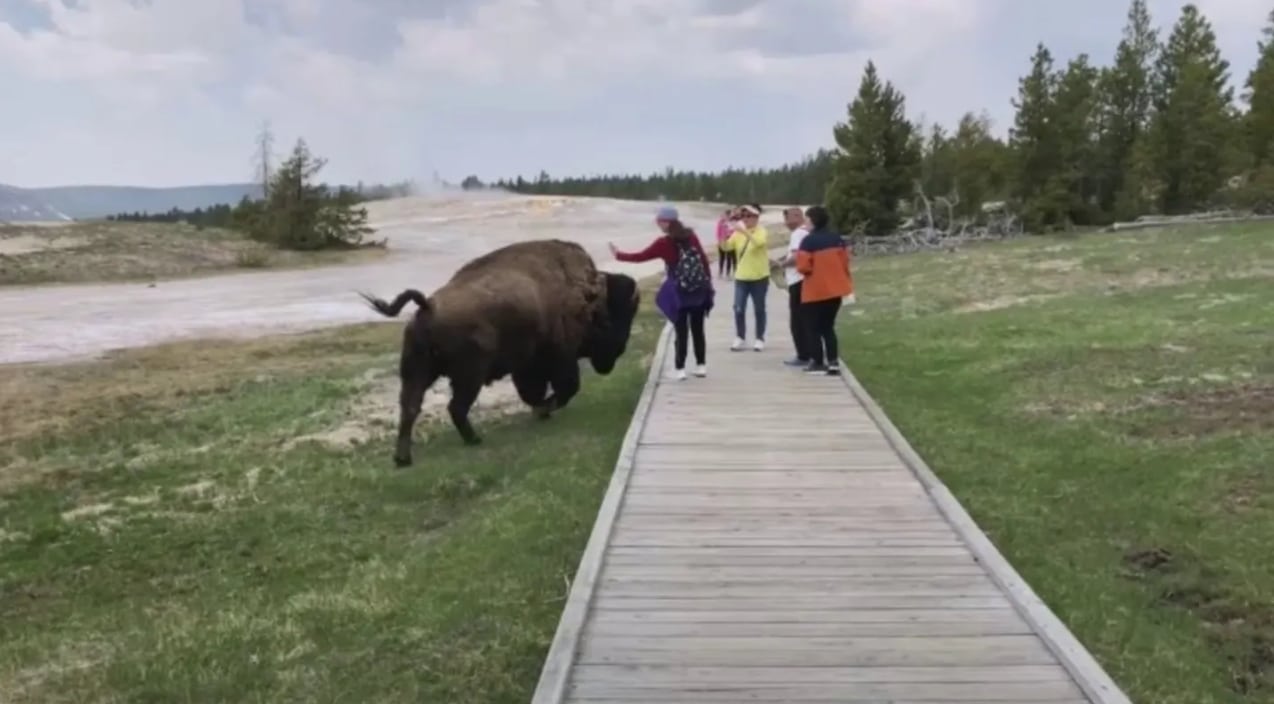In the breathtaking landscapes of Yellowstone National Park, where nature’s wonders unfold, one visitor received a hair-raising lesson in wildlife etiquette.
It all began when a group of tourists approached a bison grazing peacefully by a pathway. Like many Yellowstone visitors, they sought the perfect snapshot to capture their trip to the legendary park. Little did they know, their quest for the ultimate selfie would take an unexpected turn.
In a moment caught on camera, a woman is seen extending her hand toward the bison, her intentions seemingly innocent. But, the bison had a different idea in mind. Lowering its head with precision, the colossal creature lunged forward, its sharp horns waving around narrowly missing their target.
The tourist’s sweater became an unwilling accessory to this spine-chilling encounter, snagged by the bison’s powerful horns. Yet, through sheer determination, she managed to free herself and emerged unscathed.
The shocking incident serves as a stern reminder of the dangers associated with proximity to wild animals. Ron Magill, an ambassador from Zoo Miami, pointed out to Fox News that many individuals fail to recognize the inherent risks involved.
“People look at them and think they’re just big, hairy cows,” Magill emphasized, blaming the influence of social media for tempting individuals into dangerous behavior. Seeking validation through selfies, these daring souls jeopardize their safety without realizing the potentially grave consequences.
Bison, the largest land mammals in North America, possess a remarkable combination of strength and agility. Capable of reaching speeds of up to 35 mph and changing direction with remarkable swiftness, these formidable creatures demand both respect and distance. Yellowstone authorities strictly advise visitors to maintain a minimum of 25 yards of separation from bison, ensuring their own well-being.
Unfortunately, some individuals succumb to the allure of social media fame, ignoring these guidelines in pursuit of the perfect shot. “They’re turning their backs to a wild animal. I don’t know what they’re thinking,” Magill expressed with exasperation.
Moreover, with the calving season underway, female bison become exceptionally protective of their offspring, intensifying the risk. The males, driven by the impulses of rutting season, exhibit territorial behavior that can quickly escalate into aggression.
In analyzing the alarming video footage, Magill deciphers the bison’s body language as a clear warning sign. “When a tail goes up on a bison, that is bad news, guys, really bad news,” he emphasized. Despite these obvious signals, the woman seemed oblivious to the danger that lurked behind her seemingly harmless desire for an unforgettable encounter. Magill quips, “It’s like people think they’re at Disney World.”
Interfering with wildlife not only endangers human lives but also disrupts the delicate balance of nature. Just last week, Yellowstone Park staff were forced to euthanize a newborn bison calf after a man’s ill-advised touch led the herd to reject the vulnerable baby.
The National Park Service echoes the importance of responsible behavior, reminding tourists to respect the animals and prioritize safety for all.
As the tale of the daring tourist circulates, Yellowstone fans are left both intrigued and aghast. The captivating beauty of this national treasure serves as a constant reminder of the wonders nature bestows upon us. Let this tale be a cautionary note, urging us to cherish these magnificent creatures from a safe distance, for their well-being and our own.


